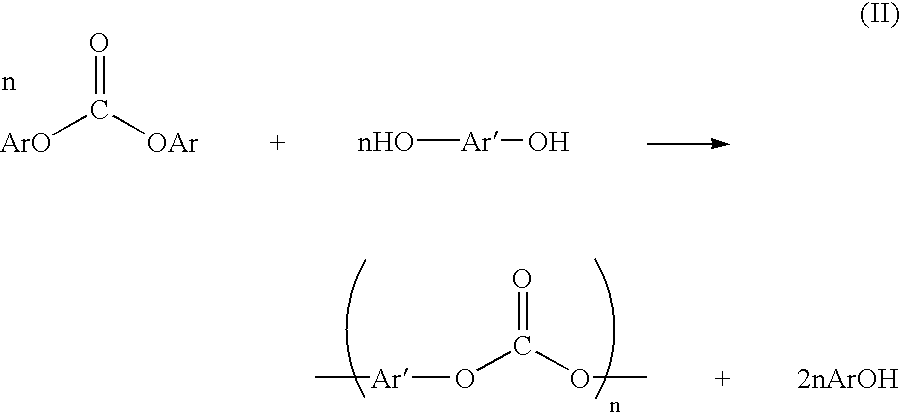Method and apparatus for preparing a dialkyl carbonate, and its use in the preparation of diaryl carbonates and polycarbonates
a dialkyl carbonate and dialkyl chloroformate technology, applied in the field of dialkyl chloroformate preparation, can solve the problems of high cost of corrosion-resistant equipment and failure to prevent corrosion in downstream separation and purification sections, and achieve the effect of efficient utilization of the time for removal of alkyl chloroforma
- Summary
- Abstract
- Description
- Claims
- Application Information
AI Technical Summary
Benefits of technology
Problems solved by technology
Method used
Image
Examples
examples 2-5
[0069] The decomposition kinetics of methyl chloroformate were studied under four different conditions. A procedure for determining methyl chloroformate in a sample was as follows. For Example 2, 32 milliliters (mL) of dimethyl carbonate, 10 mL of dimethyl carbonate containing 50 mg of a biphenyl internal standard 63 mL of methanol, and 5 ml of water were added to a 250 mL flask equipped with a thermometer, a condenser, and a port for sampling. (Toluene may be used instead of the methanol / water solution.) The resultant homogeneous solution was placed in an oil bath and the temperature of the solution was held constant at 50.degree. C. At time zero, 81.7 microliters of pure methyl chloroformate were added to the solution (1,000 ppm on a weight basis). Samples were withdrawn at various time intervals and were quenched by reacting the methyl chloroformate in the sample with diisobutyl amine to convert the methyl chloroformate to N,N'-diisobutyl methyl carbamate. The amount of N,N'-diis...
example 6
Comparative Example 1
[0072] These experiments show that the fluid passageway 110 is effective to reduce the concentration of methyl chloroformate that can react to form HCl in downstream sections of the plant. With reference to FIG. 1, two samples were obtained by sampling the process fluid at different points in a dimethyl carbonate plant having a configuration with a first heat exchanger 140 and two holding vessels 120 (i.e., a configuration corresponding to FIG. 3). The first sample (Comparative Example 1) was taken immediately before the first heat exchanger 140. The second sample (Example 6) was taken after the second holding vessel 120 (i.e., after the fluid passageway 110). Each same was taken to the lab, and its chloride content was determined as a function of time elapsed from sampling. The results are presented in Table II. The Ex. 6, data show essentially constant levels of chloride ion, indicating that labile, chloride-generating species such as methyl chloroformate are ...
example 7
Comparative Example 2
[0073] For Comparative Example 2, a dimethyl carbonate plant according to simplified FIG. 2 was operated according to the conditions described in Table III, below. This plant was similar to that shown in more detail in FIG. 1, with the exception that the first heat exchanger 140 and the fluid passageway 110 were absent. Corrosion was observed in and downstream of the azeotrope column 180. Next, this plant was modified to include the first heat exchanger 140 and two holding vessels 120 were added to increase residence time (i.e., FIG. 3 configuration). FIG. 10 presents measurements of residual ionic chlorides found in samples taken from the bottom of the azeotrope column 180, comparing the FIG. 2 and FIG. 3 configurations, each over time. Residual chlorides were determined by titration using a silver nitrate solution, as described above. The data for the FIG. 2 configuration have an average of 671 ppm chloride with a standard deviation of 370 ppm chloride, wherea...
PUM
| Property | Measurement | Unit |
|---|---|---|
| temperature | aaaaa | aaaaa |
| molar ratio | aaaaa | aaaaa |
| molar ratio | aaaaa | aaaaa |
Abstract
Description
Claims
Application Information
 Login to View More
Login to View More - R&D
- Intellectual Property
- Life Sciences
- Materials
- Tech Scout
- Unparalleled Data Quality
- Higher Quality Content
- 60% Fewer Hallucinations
Browse by: Latest US Patents, China's latest patents, Technical Efficacy Thesaurus, Application Domain, Technology Topic, Popular Technical Reports.
© 2025 PatSnap. All rights reserved.Legal|Privacy policy|Modern Slavery Act Transparency Statement|Sitemap|About US| Contact US: help@patsnap.com



